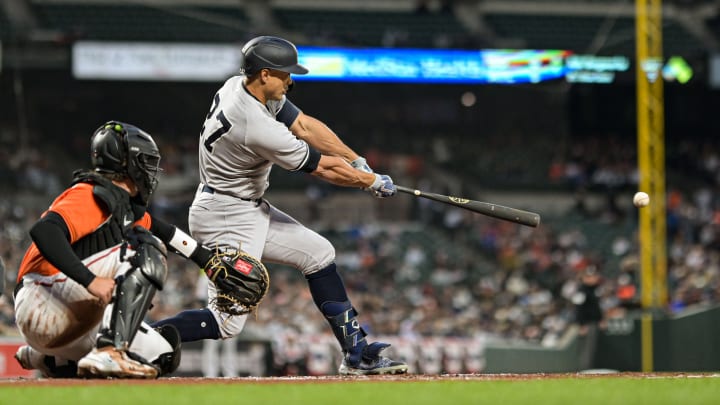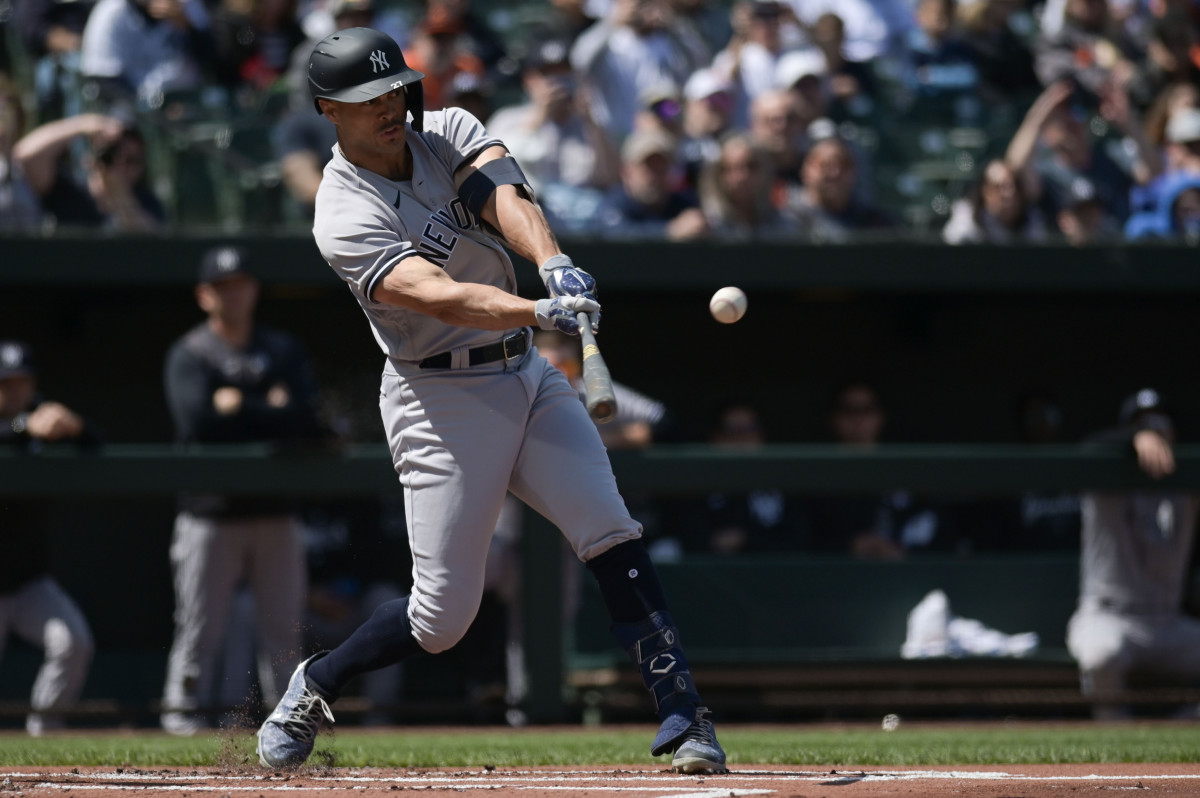How Giancarlo Stanton's Swing Makes Him the Weirdest Hitter in Baseball

After Giancarlo Stanton hit a home run 485 feet on April 2, Yankees manager Aaron Boone walked up to the slugger in the dugout and said, “You’re weird.” He meant it in the nicest way, better than how Shakespeare used the word.
Shakespeare drew upon mythology and the Old English word for fate (wyrd) to create the “weyward Sisters” of Macbeth. Subsequent editions of the play changed the adjective to “weird,” which is how the Three Witches also became known as The Weird Sisters and how “weird,” because of their strange appearance, came to mean “odd” or “uncanny.”
“Fair is foul, and foul is fair,” the Weird Sisters chant in Act I, preparing you for the moral confusion to come.
The confusing element to Stanton is physical. It is not just that he hits a baseball about as hard as any person on the planet, but that he also hits it softly (if at all) so often. And that’s why Boone channeled the Bard. In his previous swing before his 485-foot homer, which he hit 117.8 mph, Stanton mis-hit a soft lineout to shortstop at 67.9 mph. Weird.
“He does it so many times,” Boone says, referring to how Stanton can look so bad mis-hitting a ball one pitch and then send one the speed of an EF-2 tornado the next.
Stanton was at it again Saturday in Baltimore: a 74-mph groundout to third followed by a 116.3-mph home run, which created this weird scoreboard:
Home Runs Hit 116+ MPH, 2023
Giancarlo Stanton | 2 |
|---|---|
Everybody Else in MLB Combined | 1 |
There are two hitters who have long confused me about the uniqueness of how they hit: Freddie Freeman, with his abrupt, wristy swing, and Stanton, with his stiff, violent clubbing of the baseball.
Fair is foul, and foul is fair. What to make of Stanton? With the help of Yankees hitting coach Dillon Lawson, I set out to discover why Stanton is the weirdest hitter in baseball.
How weird? In the Statcast era (since 2015), Stanton has hit more balls 115 mph than every franchise. Stanton has launched 171 rockets at 115-plus, more than twice as many as the closest franchise (the Yankees, without Stanton, have 84) and more than 18 franchises combined.
But there is also this: Since being acquired in a trade from the Marlins before the 2018 season, Stanton has missed 36% of New York’s games while posting a Yankees career (.255 batting average, .840 OPS, 130 OPS+ in 456 games) that looks a lot like the one of Danny Tartabull (.254, .845, 128 in 424 games).
Stanton is enormously important to the Yankees because of the variance of his performance. When he won MVP in 2017, he hit 59 homers and slugged .631. Last year he posted career worsts in every slash category (.211/.297/.462) while missing 52 games. He is off to a .281/.324/.537 start this year.
Stanton is 33 years old, 6'6" and a chiseled 245 pounds. As Lawson says, “He must have been the Under Armour mannequin model that you see at Dick Sporting Goods.” Only four players this old and this heavy have hit 30 home runs: Frank Howard, Jim Thome, Miguel Cabrera and Adam Dunn.
I will try to put my finger on what makes Stanton unique. I have enlisted Lawson to provide help. I start by telling him about my confusion regarding how Stanton swings the bat—the sheer weirdness of it.
“It’s obviously very heavy rotational,” I say. “There’s something about his swing that’s just different from everybody else.”
“What makes you say it’s rotational?” he asks.
“I just think he gets the bat on a plane so early, and the separation of his torso and lower body is, to me, less than most. It seems like they’re turning at the same time.”
“Well,” Lawson says, “with the way that it’s split, he actually gets less rotation with his hips than a lot of hitters. Normally you would see their belt buckle open up to the pitcher or something like that. There are a lot of times where his doesn’t do that, but he still is able to pull the ball and do those things. It’s definitely one of a kind. I do agree with you that he’s able to get the bat on plane really early, which I think helps with the bat speed.”

Lawson continues: “I think about a race car. They go the fastest on the straightaways, not on the turns, right? I understand that he’s turning the bat and it’s rotating around him, but you know, when you manipulate it or you get too handsy or things like that, you’re going to decrease bat speed.
“And I think what he does is he’s able to identify pitches really early, which helps him to get the bat on plane early and then have that time to build up the bat speed. Plus, physically he’s a monster. And that barrel’s moving pretty quickly, right? So he has the physical ability, the muscular fast switch.
“It’s power-driven ability to create that bat speed that goes along with how he recognizes pitches and when he recognizes them. That package, it’s pretty unique. It’s unique.”
Getting the bat on plane early, which means the hitter drops the barrel into the height of the pitch behind the plate, is something some modern hitters disregard.
“I was talking to Julio Rodríguez’s hitting coach,” I say to Lawson. “He changed his stroke because he thinks getting the barrel in the zone early is not quick. He says nobody hits a ball back there. So, Julio is kind of like [Juan] Soto, where he wants this tight connection here ...” I mimic the barrel close to the head ... “and here,” dropping the imaginary barrel quickly into the hitting area.
“Two different methods,” Lawson says. “Obviously, I would agree with that assessment, that you draw a circle around you. But it’s a tight circle. And you don’t want it to disconnect from the shoulder early here where you’re casting the barrel, right? And then draw this circle. You want to have this turn here ...” Lawson tucks the back arm close to the body ... “and then you’re connected to eventually disconnect.”
“Gotcha.”
“But he does it in a way where a lot of hitters still come with the bat kind of angled [up], and it’s steep and then it flattens out and then it comes back up. So the way he sets it, he’ll set it perpendicular to his spine, and then he rotates with it attached to his shoulder and then connected—it’s flat all the way.”
“That’s interesting. Well, explain to me how it’s different.”
“It’s hard to put into words. I mean, it’s unique. We’ve talked a lot about his bat path, his attack angles and things like that. And it is a unique deal where it’s like, I wouldn’t want anyone else to have his flow of attack angles. But he can do it because he generates so much bat speed that he actually can hit a ball out where he didn’t actually square it up.
“When you come in with more of that negative attack angle, that’s where he’s able to take some length out in the bat path. So, it helps manage contact rate.”
“That’s so funny because nobody’s teaching that now.”
“Right.”
At that moment Yankees rookie Anthony Volpe stepped into the cage to hit. Volpe uses a negative attack angle and keeps his palm up through and after contact. More traditionally, Stanton rolls the top wrist.
“I look at the way both of these swings work,” I say while pointing to Volpe, “and that’s kind of typical what you see from someone under the age of 25 now, right?”
“Anthony will have a more vertical bat angle. Sure. Even watching him take BP you say, ‘Oh, the kid shouldn’t play around in the air that much. He’s a below-average-size player, and speed is his game. Contact and speed is his game.’ But he can drive balls out the ballpark. So, he’s very capable of stealing bases and hitting extra base hits.”
Volpe changed his swing in 2020, when the minor leagues were shut down due to COVID-19.
“What’s interesting is when they drafted him,” Lawsons says, “he wasn’t really projected to be a big power guy. He basically learned to adjust to hit the ball in the air. It’s pretty cool. I remember the old form.”
“That’s a different swing then, right?”
“It was. He wasn’t rotating very well. It was a very handsy swing, and his hands went too early. So, the sequence wasn’t optimal for power to, to say the least. It was probably optimal for contact. But I think the game is at a place where you’re trying to optimize ... like you’re trying to find this balance of both. Given how good pitching is, you’re not going to single him to death. But you also can’t swing and miss too much.”
Because of Volpe’s upward attack angle, major league teams are pounding him with high fastballs. Twenty-four percent of the pitches he sees are fastballs above the belt. Volpe is 0-for-9 against them with four strikeouts.
With Stanton’s flatter path, he is better suited to attacking high fastballs. He is hitting .308 on fastballs above the belt. Boone also raves about how Stanton prepares and how he is so focused on a plan. “He is very disciplined about what he is doing at the plate,” the manager says.
Focus, size, strength and elite bat speed allow Stanton to remain such a dangerous hitter despite a “weird” swing. He has 380 career home runs and is signed through 2027. His average of 22.6 home runs through his first five seasons with the Yankees puts him in range of 500 home runs and the Hall of Fame by the end of this contract. His career at age 33 looks like the ones of Harmon Killebrew and Ralph Kiner, without as many home run titles. (Stanton has two.) He has been one of the game’s greatest postseason sluggers (.635). Only four players with at least 100 postseason plate appearances have slugged better: Babe Ruth, Lou Gehrig, Randy Arozarena and Lenny Dykstra.
Injuries and age have slowed Stanton’s progress and reduced his athleticism—cutting his speed on the bases and ability to hit elite velocity. When the Yankees traded for him, for instance, Stanton ranked in the top 70th percentile in sprint speed (27.8). Last year he was down to the fifth percentile (24.5). He took the extra base 35% of the time with the Marlins but has done so only 22% of the time with the Yankees.
Last season pitchers threw him pitches 95+ mph more than ever before (22%), and Stanton did less with them than ever before (.190). Only five hitters were worse against elite velocity (minimum 400 such pitches). He saw even more elite velocity in the postseason (25%) and hit .143 against such heat. Over the past five seasons he has hit only seven home runs off pitches 95-plus mph. In his MVP year alone, he hit nine.
What do the Yankees have in Stanton? It depends first on his health. He has taken 500 at bats as a Yankee twice and returned 38 and 35 home runs. Boone plans to give him one or two starts a week in the outfield to maintain the fitness of his legs.
After health, his success relies on pitch recognition, bat speed, size and strength more than on technical swing precision. Stanton can look awful one swing and win a game with the next. At 33, he remains a game-changing if inconsistent talent who still hits the ball as hard as anyone.
